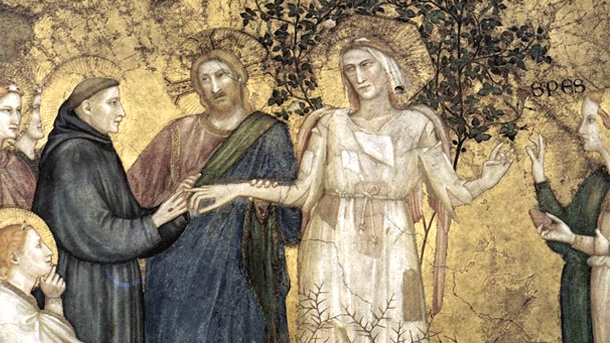



Inside the Basilica of Saint Francis: a lesson in catechetics
Sebastian Gomes
Tuesday, September 9, 2014

St. Francis weds Lady Poverty in the presence of the risen Christ (From the main apse in the lower church of the Basilica of St. Francis)
Protruding from the mountainside town of Assisi is the medieval Basilica of Saint Francis. From a distance the basilica looks almost as big as the town itself; a simultaneous testament to the Saint’s widespread influence and modest origins.
Still, the basilica is what most moderns would expect from an important medieval church: majesty, stunning architecture and extraordinary artistry. But look a little closer and the details also reveal a living spirit, with a keen pastoral and theological sense, and a bold effort to evangelize and catechize by adapting the timeless teachings of the Gospel to the lives of ordinary people.
The Second Vatican Council made the unprecedented decision of issuing a document that would look carefully at the Church’s relationship with the modern world. There is no authoritative document quite like Gaudium et Spes in the history of the Church. But it is not the first time an attempt to bridge the Church and the contemporary world has been made. The Basilica of Saint Francis is a perfect example.
The basilica consists of three levels: the upper church, the lower church (which was designed as a crypt), and the tomb of Saint Francis that lies beneath. Today it is quite common to see the old Romanesque arches and vaulted ceilings in churches across Europe. The lower church of the Basilica of Saint Francis was, in fact, one of the first major ecclesial structures to be built entirely in that style.
Both the upper and lower levels are lined with beautiful 13th and 14th century frescos depicting the life of Christ juxtaposed to the life of Francis. They are the largest medieval frescos, in terms of surface area, in the world.
Never in the history of Christian art had the life of an individual been so clearly compared with the life of Christ. The anonymous Italian painter known as the “Master of St. Francis” was, together with the Franciscan community, making a powerful and provocative statement about Francis.
The frescos themselves had a very practical purpose: they were the teaching tools for the people. In a world where very few could read or write, catechesis was done through images. The four-paneled apse of the lower basilica is a masterful work of pastoral and theological catechesis. The panel behind the altar depicts Francis enthroned in glory surrounded by the heavenly host. The painting is such that the angels appear in three dimensions, a technique which would define the Renaissance period approx. one hundred years later.
The other three panels depict the cardinal virtues of Franciscan life: poverty, chastity and obedience. They are filled with symbolism and images that must have sparked the imagination and provoked deep reflection. For the first time in Christian art we see images in the context of the natural world, that is, with trees, vines, grass and flowers in the background. This was a development, and a highly appropriate one considering Francis’ love of the natural world.
Many of the frescoes depict secondary characters and bystanders in the clothing of the day. This can easily go unnoticed, but the people of the 13th century would have recognized, for example, the familiar Florentine dress on the three magi above the right transept. Imagine today walking into the church of a contemporary saint and seeing characters painted in jeans or a suit and tie!
The objective of these marvelously talented 13th artists was quite simple: bring the people of their day into the story of St. Francis, which was really the story of Christ. Spark the imagination of the masses and open the path of discipleship to anyone and everyone. We might do well to think a bit more outside-of-the-box and take risks in order to entice and inspire the people of our time with our timeless message.
Check out Sebastian's first post from Assisi!
Related Articles:
<<
SUPPORT LABEL
$50
$100
$150
$250
OTHER AMOUNT
DONATE
Receive our newsletters
Stay Connected
Receive our newsletters

Stay Connected







